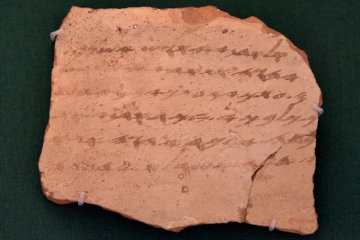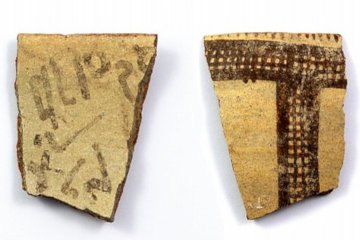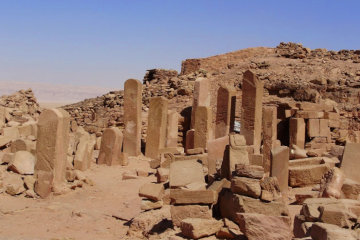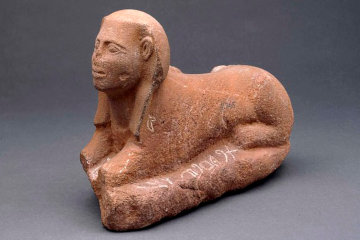The Earliest Alphabet?
I can't say that I enjoy actually doing archaeology. Reading about it, fine; getting my hands dirty, no. My father enjoyed it and seemed to find unearthing a bit of ancient pottery thrilling and fulfilling - and I'll admit that there is mild satisfaction in uncovering a complete lamp (which is about as dramatic as my finds have ever been), but then you look at all the buckets of dirt you had to scrape up and carry away to find the lamp and the satisfaction quickly fades.
But perhaps the worst part of a "dig" is the washing up afterwards. I'm not talking about the dishes after that early morning breakfast. I'm talking about the fact that when work finally stops at 2.00 and all the tools are gathered up and the find boxes carefully transported back to wherever you are staying, you then have to spend an hour or more washing every single piece of pottery.
Why? An housewifely concern for clean dishes? A distaste for slovenliness? A desire to have even the tiniest fragment ready for display in a museum? (Fat chance!) No, it is the hope that one of those bits of pottery will turn out to be the elusive pot of gold at the end of the rainbow - an ostracon!
Now strictly speaking, all broken pottery are "ostraka" - I believe the word is Greek and simply means "shell" - but we don't dignify your ordinary fragment of dinner plate or drinking cup with the term. It has come to mean a bit of pottery on which one or more letters have been scrawled or scratched.
In an era when the only writing material was expensive papyrus imported from Egypt, if you wanted to jot a note to yourself you picked up a bit of broken pottery - of which there was never any lack - and whipped out your dagger to scratch the message into the surface. If you were a scribe, you might use reed pen and lampblack ink, but the principle was the same.
Like all post-it notes, such communications tend to be cryptic: "Tues. doc appt" and correspondingly hard to interpret. Just occasionally you will find larger bits of pottery on which are complete and complex messages - after which you write a monograph, earn a doctorate, and retire covered in glory!

| |
| Lachish Letter II, in which the author wishes peace to Ya'osh, the military commander in Lachish. |
The most famous of these larger ostraca are the "Lachish Letters", which were found in a guard room at Tel ed-Duweir, the site of Biblical Lachish. The garrison commander seems to have had a lengthy correspondance with various people, in the course of which he mentions the arrest of a prophet who had fled to Egypt, protests against accusations of neglect or incompetance, and most dramatic of all, reports that he can no longer see fire signals from nearby Azekah, indicating that Azekah had finally fallen to the enemy. He would have been able to guess that Lachish was next on the list, a bit of knowledge that did him no good at all, as his precious letters were found under a layer of ash from his destroyed guard room.

| |
| The newly discovered ostracon from Lachish, written on a fragment of Cypriot ware. |
A more typical ostracon is the one which has only recently been discovered, also at Lachish. It is a piece of imported Cypriot pottery, which on one side is decorated with two bands of hatched lines that cross each other. On the other side are what appear to be nine letters which may spell the words "slave" and "honey".
"Slave" - 'bd in Hebrew - was a common part of a personal name. In the Bible we have "Ebedmelech" - the king's slave; in modern Arabic we have "Abdullah" - God's slave. Once they had served their purpose, these ancient post-it notes were just dropped on the ground where they might be trodden on again and further broken, so it is quite possible that this is part of someone's name and the reference to honey may imply that the letter 'l' should be before the name - whatever it was - to indicate "honey belonging to ...slave".
However the significant thing about this particular ostracon is not its message, for we may never get to the bottom of what it is all about. The interesting thing is the writing itself. The dating of Cypriot ware is well established, so we can date the pottery fairly accurately to approximately 1450 BC - the Late Bronze Age. According to conventional Biblical chronology, the Exodus took place in 1445 BC; according to the Revised Chronology which I prefer, the Exodus was several centuries earlier, meaning that this bit of pottery was from the time of the judges or possibly even the early Israelite kings.

| |
| A cluster of Egyptian stele at Serabit el-Khadim. |
The letters on the ostracon bear a resemblance to Egyptian hieroglyphs but are definitely not hieroglyphs; they are, in fact, similar to the writing found at Serabit el-Khadim in the Sinai. Serabit was a turquoise mine, miles from anywhere, with no nearby sources of water or food. Mounting an expedition there was a major undertaking and the leaders of such expeditions tended to put on side something dreadful and leave monumental stele swanking about their achievements.
The people who did the actual mining, in the cramped, dark and dangerous tunnels, appear to have been Semites. It is not clear whether they were enslaved prisoners of war or locals eager for high rates of pay, but whatever they were, they clearly had time on their hands to stand around and watch as some scribe painstakingly chipped an inscription into a piece of local stone - and at least one of them realised that the man was creating language with those funny pictures. He may even have got chatting to the scribe and asked what they represented.
The scribe, who was quite a friendly chap and didn't mind a break from his work, was only too happy to put down his chisel and become expansive. He pointed to the picture he had just carved - a sort of horizontal rectangle with an opening at the bottom and said, in excrable pidgin Semitic, "That's 'per', a house - you know, 'beit' in your language."
The workman went away and as he hacked at the turquoise next day muttered to himself, "Beit - rectangle with a door. Beit. Hmmmm. And what was that bull's head? Aleph? Double-hmmmm."
And then it struck him: put the bull's head in front of the house and you have "alphabeit"!
Sitting around the campfire that night he shared his big idea with the other workmen, most of whom told him he was mad, but a couple were sufficiently intrigued to start scratching their crude approximations of hieroglyphs onto bits of stone and one man even dedicated a badly carved sphinx with the words "Beloved of Baal'at" scratched into the base.

| |
| A small sphinx from Serabit el-Khadim on which has been scratched a proto-Sinaitic inscription. |
A short while later a wandering herdsman happened by - well, not exactly "happened". He had actually come all the way from Midian, over by the Gulf of Aqabah, intending to sell a few sheep to the Egyptians. Once that was done he naturally fell into conversation with his fellow Semites and one of them shared this new idea for "writing" with the man.
"That's interesting!" the herdsman exclaimed. "Tell me more. You see, I have this idea for a long poem about a man who lost everything and had long conversations with four chaps who came to sympathise with him, but it's not the sort of thing you could write in hieroglyphs."
"You can write hieroglyphs?" the turquoise miner exclaimed.
"Oh yes," the herdsman replied. "Long story, but I wasn't always a shepherd, you know."
Well, that is obviously my fantasy, but the fact is that the turquoise miners at Serabit el-Khadim did invent an alphabetic script, it was based on hieroglyphs but the hieroglyphic symbols were given Semitic names and values, and it was at about the time that Moses was wandering with his flock near Mt Sinai. It is not at all impossible that Moses should have come across the new form of writing, either from visiting Serabit (as I have imagined) or by meeting miners who had either escaped (if slaves) or whose contracts had come to an end (if workmen attracted by high wages).
Certainly someone carried the idea beyond the turquoise mines and this latest ostracon, found by an Austrian team back in 2018 but only just published, is the oldest alphabetic writing yet found in Palestine. Even if we accept conventional chronology, it shows that the early Hebrews - and Moses in particular - were able to write in a proto-Hebraic script. We need not postulate hundreds of years of oral tradition before the books of Moses were written down; Moses could have written them himself - though fortunately, he had access to papyrus and wasn't dependent on broken pottery for his magnificent epic poem about the sufferings of Job.
© Kendall K. Down 2021





